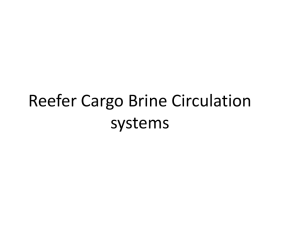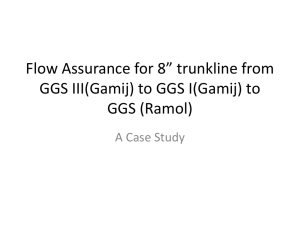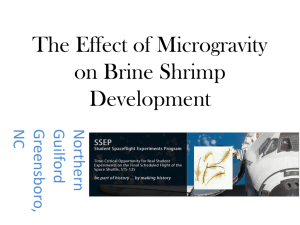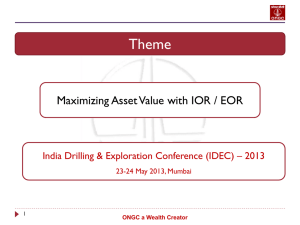Presentation
advertisement
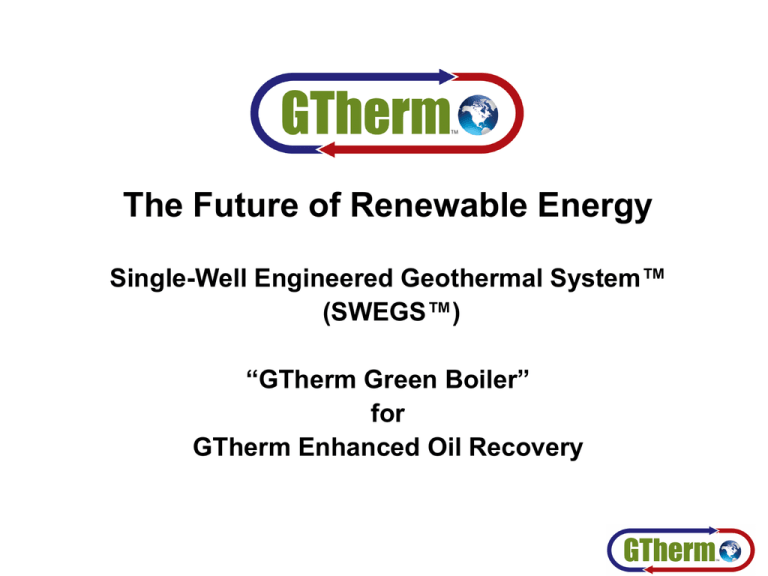
The Future of Renewable Energy Single-Well Engineered Geothermal System™ (SWEGS™) “GTherm Green Boiler” for GTherm Enhanced Oil Recovery 1 1 The GTherm Team R&D Modeling: Dartmouth Research: EPRI Engineering and Equipment Drilling and Tools Logistics and Controls EPC: Power Plant Design: Lehr Consulting Int’l, NY Drilling: Nabors Industries, Bermuda Accounting Logistics: Tax & Audit: NYC IFS, IL • 12 patents filed 2 Geology: Lehigh University Heat Pipes: Aavid Corp., NH Optimization: US DOE Turbines/Generators: TAS Energy, TX Drilling: Baker Hughes, TX Security and Control: Tangible Software, VA Legal: NYC GTherm Green Boiler Thermal Energy SWEGS ° 87.7°C HeatNestTM ° 87.7°C 3 • 17.5” (0.45m) diameter well drilled to region of hot rock • Lateral holes drilled out into hot rock • Heat pipes grouted into lateral holes to harvest heat and bring it to central well • Heat exchanger transfers heat into closed loop • Closed loop brings heat to surface • Heat pumped to heat/production reservoir wells How a GTherm HeatNest Works Cool Water is Pumped In Hot Water is Pumped Out Heat Heat HeatNestTM Heat Heat Heat 4 Heat Heat Heat Geothermal Energy Replenishes Itself GTherm HeatNest Appendages 5 GTherm Heat Extraction Design Flexibility • Depth of well • Length of the heat exchanger • Start of the heat zone • Number of appendages • Length of the appendages • Heat equilibrium determination • Pump rate (gpm) 6 GTherm SWEGS is a Closed-Loop System Constant and Continuous Heating • The water coming from the HeatNest to the pump is continuously recycled (i.e. No Waste Water) • No groundwater contamination • The only thing removed by this system is continuously replenishing geothermal energy / heat. • The GTherm SWEGS is designed to pull heat from earth at 20% less than the refresh rate • The heat resource is constantly replenished and never consumed Environmentally Safe • • • • 7 No fossil fuels No greenhouse gas (GHGs) or other emissions No chemicals required for extraction Eliminates aquifer and surface water contamination GTherm Green Boiler Applications Electricity Enhanced Oil Recovery Data Centers 8 Desalination Fish Farming Greenhouses Mining HVAC Drying Etc. Why it Works • SWEGS is modeled after heat pumps • There are millions of heat pumps installed and operating worldwide Small Commercial Heat Pump Length (meters ) Well Diameter (i nches ) Heat Length (meters ) Exchange Diameter (i nches ) Low / High Heat ° C BTU / h 9 SWEGS Heat Pump SWEGS 23 - 150 1,000 - 5,000 6.0 17.5 80 - 110 1,000 2- 3 13.5 10 / 16 95 / 315 12,000 34,000,000 GTherm is Not Limited to the Ring-of-Fire High-Temperature Areas 10 GTherm: • Enhanced Oil Recovery • Enhanced Oil Storage • Enhanced Oil Transport 11 Global Distribution of Conventional Crude Oil and Heavy Hydrocarbons 12 GTherm EOR Breakthrough Comparison Legacy Technology • Water flooding – Light Crude • CO2 flooding – Light Crude • Polymer flooding – Light Crude • Steam flooding – Heavy Crude • Fire flooding – Heavy Crude GTherm EOR • No fresh water • No gases or chemicals • No burning fossil fuels • No greenhouse gases (GHGs) 13 • Adverse environmental impact • Use of water • Huge supply & cost of: • Water • Gas • Chemicals • Cost of fuel • Permitting problems • Greenhouse gases Heating Oil Lowers Viscosity Viscosity Crude Oils (centipoise) Tar, Bitumen Extra Heavy Oil 108 Window putty 107 Caulk 106 Vegetable shortening 105 Peanut butter 104 Tomato ketchup Heavy Oil 103 Viscous Oil 102 Molasses Honey Maple syrup 10 Light Oil 1 14 Familiar substances Corn oil Water Crude Oil Composition Composition by Weight Hydrocarbon Average Paraffins 30% 15 to 60% Naphthenes Aromatics 49% 15% 30 to 60% 3 to 30% Asphaltenes 15 Range 6% Remainder Melting / Liquification Point 115°F to 155°F 46°C to 68°C 180°F 82°C Heating the oil lowers the viscosity and significantly improves flow The oil mobility is the ratio of the effective permeability to the oil flow to its viscosity. This is given by Viscosity is denominator 16 Source: Argonne National Laboratory Crude Oil Viscosity High Viscosity Increased Heat 17 Medium Viscosity Low Viscosity Heavy Crude Oil Viscosity/Heat in Known Fields GTherm Target Temperature 18 Source: Argonne National Laboratory Constant Consistent Heating of the Oil Field Spreads the Heat and Increases Flow Heat moves through conduction Heat moves through toroidal convection of water and oil in the permeable zones 19 Why GTherm for EOR? Cost Effective 20 • Each SWEGS can support multiple applications, heat delivery wells and Hot Water Flooding systems • No fossil fuel burned • No chemicals or CO2 used for oil recovery GTherm EOR System Heat Assisted Gravity Drainage & Hot Water Flooding (Recycling) Oil Oil Water / Brine Separator Cool Water/Brine SWEGS Green Boiler Heat Exchanger Heat Extraction Hot Water / Brine Oil Water/Brine Wells Heat Delivery Well Hot Water Flooding (Recycling) Well Heated Oil & Water / Brine Reservoir Oil & Water / Brine Reservoir 21 Ground level GTherm EOR System SWEGS & Closed-Loop Heating System Green Boiler Heat Extraction Heat Exchanger Heat Delivery Well Heated Oil & Water / Brine Reservoir Oil & Water / Brine Reservoir Cold Waterisis pumped the The water then heated inreservoir the SWEGS SWEGS cooled water from into the and Heat Wellcirculates well backreturned to the Heat heat and exchanger is then to the Exchanger and the Heat Delivery and Well, SWEGS well where it is reheated Which heats Reservoir. recycled backthe through the system. 22 SWEGS Ground level GTherm EOR System Heat Assisted Gravity Drainage + Hot Water Flooding Oil Oil Water / Brine Separator Cool Water / Brine Heat Exchanger Hot Water / Brine Ground level Oil Water/Brine Wells Hot Water Flooding Well Heated Oil & Water / Brine Reservoir Oil & Water / Brine Reservoir 23 TheThe heat oilfrom / water the Hot Water / Brine separator brine melts then and separates isthe pumped / drained mobilizes oil from the thebrine into reservoir. heavy andthe recirculates crude andthe recirculates brine back to to the the production heat exchanger. wells. The Operating GTherm System Closed-Loop and Hot Water Recycling System Oil Oil Water / Brine Separator Cool Water/Brine SWEGS Green Boiler Heat Exchanger Hot Water / Brine Oil Water/Brine Wells Heat Delivery Well Hot Water Flooding Well Heated Oil & Water / Brine Reservoir Oil & Water / Brine Reservoir 24 ALL of the Water ispower Recycled The potential only electrical exists to complete required anis to autonomous operate the pumping / independent system system by adding an electrical generation system, which would allow the GTherm system to generate its own electrical power. Ground level Heat Extraction GTherm EOR Implications • A depleted oil well still has over 70% of its oil in place. • The extraction rate of the oil in an operating well is dependent on viscosity. • The GTherm EOR method can be applied to depleted wells or to currently operating wells. • With GTherm EOR a discovered oil field can now be booked on the balance sheet at 80+% of the oil in place (more than doubling the assets on the balance sheet). • For depleted oil wells an asset of 55+% of the oil in place can be booked as an asset on the balance sheet. 25 GTherm Heat Delivery/Production Well From GTherm SWEGS Heat Extraction Well GTherm Heat Delivery/ Production Well 26 GTherm Heat Delivery/Production Well with Existing Production Well 27 GTherm Reservoir - Design Implications • Design to hit the high points of the pay zone with target heat delivery • Design to adjust to the dips in the oil bearing zones • Design the heat injection to focus on the oil flow to collection points • Strategically place the heat delivery wells to maximize the performance of the existing wells • For new implementations integrate the heat delivery wells with the production wells 28 GTherm EOR vs. Legacy EOR Costs GTherm cost per barrel including carbon pricing 29 Source: World Petroleum Council: Official Publication 2010 Ex: Alberta Oil Sands–challenges of using large volumes of water and creating GHG 1. 2. 3. 4. 5. 6. Oil sands mining is licensed to use twice the amount of fresh water that the entire city of Calgary uses in a year. The water requirements for oil sands projects range from 2.5 to 4.0 barrels of water for each barrel of oil produced. At least 90% of the fresh water used in the oil sands ends up in tailing lakes so toxic that propane cannons and floating scarecrows are used to keep migrating ducks landed on a tar sands toxic lake and dying. The toxic lakes in Northern Alberta span 50 square kilometers and can be seen from space Processing the oil sands uses enough natural gas in a day to heat 3 million homes in Canada.. Producing a barrel of oil from the oil sands produces three times more greenhouse gas emissions than a barrel of conventional oil. The oil sands operations are the fastest growing source of heat-trapping greenhouse gas in Canada. By 2020 the oil sands will release twice the amount produced currently by all the cars and trucks in Canada. By 2015, the Alberta Oil Sands are expected to emit more GHG than the nation of Denmark (pop. 5.4 million). GTherm EOR: No water, No greenhouse gases, No fossil fuels 30 GTherm EOR Example – Depleted Wells Barrels Extracted 1,000,000 2,000,000 3,000,000 4,000,000 5,000,000 10,000,000 15,000,000 20,000,000 25,000,000 30,000,000 35,000,000 40,000,000 50,000,000 75,000,000 100,000,000 31 Barrels in % with EOR Place Extractable 3,000,000 65% 6,000,000 65% 9,000,000 65% 12,000,000 65% 15,000,000 65% 30,000,000 65% 45,000,000 65% 60,000,000 65% 75,000,000 65% 90,000,000 65% 105,000,000 65% 120,000,000 65% 150,000,000 65% 225,000,000 65% 300,000,000 65% Barrels Price per Oil Value Extractable Barrel (000) 1,950,000 $75.00 $146,250 3,900,000 $75.00 $292,500 5,850,000 $75.00 $438,750 7,800,000 $75.00 $585,000 9,750,000 $75.00 $731,250 19,500,000 $75.00 $1,462,500 29,250,000 $75.00 $2,193,750 39,000,000 $75.00 $2,925,000 48,750,000 $75.00 $3,656,250 58,500,000 $75.00 $4,387,500 68,250,000 $75.00 $5,118,750 78,000,000 $75.00 $5,850,000 97,500,000 $75.00 $7,312,500 146,250,000 $75.00 $10,968,750 195,000,000 $75.00 $14,625,000 GTherm Enhanced Oil Storage Sludge in Storage Tanks and Sludge Pools 32 SWEGS – Changes the Viscosity of Sludge in Storage Tanks & Sludge Pools to Flowing Crude Cooler Water Pumps Cooler Water Hot Water Hot Water SWEGS OIL Crude OIL Storage Tank or Storage Pools Sludge 33 SWEGS – Changes the Viscosity of Sludge in Storage Tanks & Sludge Pools to Flowing Crude 34 GTherm Enhanced Oil Transport • To pump oil through a pipe line the oil need to have a low viscosity • As heavy crude travels through a pipe over distance it cools and viscosity increases decreasing pumping performance • To reduce viscosity companies are either: – heating the pipes by burning fossil fuel – mixing the heavy crude with lighter crude – adding solvents to the heavy crude • GTherm uses strategically placed SWEGS to heat the pipeline and reduce the viscosity of the oil thereby increasing the efficiency to the pipe line. 35 GTherm Enhanced Oil Transport Design Heating Exchanger Colder Oil Warmer Oil Hot Water SWEGS 36 Cooler Water GTherm Enhanced Oil Transport Design Objective: To Keep the Oil at Low Viscosity Miles Miles Miles Oil Pipeline GTherm SWEGS Heating Stations 37 Energy-Food- Water Nexus “The biggest obstacle to sustainable long-term socio-economic growth” E&Y 38 GTherm Structure GTherm, Inc. Holdings (US) GTherm International (US) 39 Shared Services Legal & Finance Business Development SWEGS Engineering SWEGS Drilling R&D IT/NOC Components The Future of: Enhanced Oil Recovery Enhanced Oil Storage Enhanced Oil Transport Thank You For More information please contact Mark Henderson Axess1 group, LLC dba A1 Green Energies 678-653-5554 mark@axess1.com


